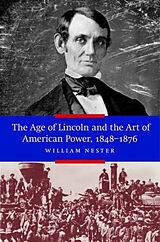The Age of Lincoln and the Art of American Power, 1848-1876
Einband:
Fester Einband
EAN:
9781612346588
Untertitel:
Englisch
Genre:
Geschichte
Autor:
William Nester
Herausgeber:
Potomac Books
Anzahl Seiten:
376
Erscheinungsdatum:
01.02.2014
ISBN:
978-1-61234-658-8
Informationen zum Autor WILLIAM NESTER is a professor at St. John's University in New York City and the author of more than thirty books on various aspects of international relations, including four for Potomac Books: The Revolutionary Years, 17751789; The Hamiltonian Vision, 17891800; The Jeffersonian Vision, 18011815; and The Age of Jackson and the Art of American Power, 18151848. He lives in New York City. Klappentext Although Abraham Lincoln was among seven presidents who served during the tumultuous years between the end of the Mexican War and the end of the Reconstruction era, history has not been kind to the others: Zachary Taylor, Millard Fillmore, Franklin Pierce, James Buchanan, Andrew Johnson, and Ulysses Grant. In contrast, history sees Abraham Lincoln as a giant in character and deeds. During his presidency, he governed brilliantly, developed the economy, liberated four million people from slavery, reunified the nation, and helped enact the Homestead Act, among other accomplishments. He proved to be not only an outstanding commander in chief but also a skilled diplomat, economist, humanist, educator, and moralist.Lincoln achieved that and more because he was a master of the art of American power. He understood that the struggle for hearts and minds was the essence of politics in a democracy. He asserted power mostly by appealing to people s hopes rather than their fears. All along he tried to shape rather than reflect prevailing public opinions that differed from his own. To that end, he was brilliant at bridging the gap between progressives and conservatives by reining in the former and urging on the latter.His art of power ultimately reflected his unswerving devotion to the Declaration of Independence s principles and the Constitution s institutions, or as he so elegantly expressed it, to a government of the people, by the people, and for the people. Zusammenfassung Although Abraham Lincoln was among seven presidents who served during the tumultuous years between the end of the Mexican War and the end of the Reconstruction era! history has not been kind to the others: Zachary Taylor! Millard Fillmore! Franklin Pierce! James Buchanan! Andrew Johnson! and Ulysses Grant. Inhaltsverzeichnis Introduction: Abraham Lincoln and the Art of PowerPart 1. Manifest Destiny, 184818601. Eighteen Forty-Eight2. Young Lincoln3. Uncle Tom's Cabin4. Bleeding Kansas5. Dred Scott and Harpers Ferry6. The ElectionPart 2. Civil War, 186118657. Limited War8. Emancipation9. The Hamiltonian Triumph10. Turning Points11. Total War12. With Malice toward NonePart 3. Reconstruction, 1865187613. Revolution14. Night Riders and Black Codes15. Frontiers16. Eighteen Seventy-Six17. LegacyList of AbbreviationsNotesIndex...
Autorentext
WILLIAM NESTER is a professor at St. John’s University in New York City and the author of more than thirty books on various aspects of international relations, including four for Potomac Books: The Revolutionary Years, 1775–1789; The Hamiltonian Vision, 1789–1800; The Jeffersonian Vision, 1801–1815; and The Age of Jackson and the Art of American Power, 1815–1848. He lives in New York City.
Klappentext
Although Abraham Lincoln was among seven presidents who served during the tumultuous years between the end of the Mexican War and the end of the Reconstruction era, history has not been kind to the others: Zachary Taylor, Millard Fillmore, Franklin Pierce, James Buchanan, Andrew Johnson, and Ulysses Grant. In contrast, history sees Abraham Lincoln as a giant in character and deeds. During his presidency, he governed brilliantly, developed the economy, liberated four million people from slavery, reunified the nation, and helped enact the Homestead Act, among other accomplishments. He proved to be not only an outstanding commander in chief but also a skilled diplomat, economist, humanist, educator, and moralist.Lincoln achieved that and more because he was a master of the art of American power. He understood that the struggle for hearts and minds was the essence of politics in a democracy. He asserted power mostly by appealing to people s hopes rather than their fears. All along he tried to shape rather than reflect prevailing public opinions that differed from his own. To that end, he was brilliant at bridging the gap between progressives and conservatives by reining in the former and urging on the latter.His art of power ultimately reflected his unswerving devotion to the Declaration of Independence s principles and the Constitution s institutions, or as he so elegantly expressed it, to a government of the people, by the people, and for the people.
Inhalt
Introduction: Abraham Lincoln and the Art of Power
Part 1. Manifest Destiny, 1848–1860
1. Eighteen Forty-Eight
2. Young Lincoln
3. Uncle Tom’s Cabin
4. Bleeding Kansas
5. Dred Scott and Harpers Ferry
6. The Election
Part 2. Civil War, 1861–1865
7. Limited War
8. Emancipation
9. The Hamiltonian Triumph
10. Turning Points
11. Total War
12. With Malice toward None
Part 3. Reconstruction, 1865–1876
13. Revolution
14. Night Riders and Black Codes
15. Frontiers
16. Eighteen Seventy-Six
17. Legacy
List of Abbreviations
Notes
Index

Leider konnten wir für diesen Artikel keine Preise ermitteln ...
billigbuch.ch sucht jetzt für Sie die besten Angebote ...
Die aktuellen Verkaufspreise von 6 Onlineshops werden in Realtime abgefragt.
Sie können das gewünschte Produkt anschliessend direkt beim Anbieter Ihrer Wahl bestellen.
Loading...
Die aktuellen Verkaufspreise von 6 Onlineshops werden in Realtime abgefragt.
Sie können das gewünschte Produkt anschliessend direkt beim Anbieter Ihrer Wahl bestellen.
| # | Onlineshop | Preis CHF | Versand CHF | Total CHF | ||
|---|---|---|---|---|---|---|
| 1 | Seller | 0.00 | 0.00 | 0.00 |
